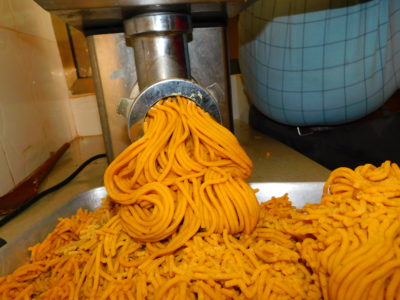Scientists at the International Potato Center (CIP) have welcomed a recent study supporting the commercial processing of biofortified orange-fleshed sweetpotato (OFSP). The study—focusing on industrialisation of baby food processing—demonstrates how the addition of vitamin A-rich sweetpotato would enhance the nutritional quality of baby food to children under six years of age in many developing countries.

The study—published in the prestigious Frontiers in Nutrition journal—approves the formulation of orange-fleshed sweetpotato proposed in tested samples, which also incorporates pumpkin, oil and egg yolk, as a way of improving the overall safety and quality of the baby-food product. In particular the researchers noted that the formula would maximize carotenoid bioaccessibility of the food which facilitates the absorption of vitamin A. The samples underwent industrial heat processing mainly pasteurization and sterilization.
“Based on this work, we recommend the development of functional baby food OFSP puree as a way to reduce the risk of vitamin A deficiency (VAD) and improve public health,” the paper reads.
A research-for-development organization with a focus on potato, sweetpotato and Andean roots and tubers, CIP delivers innovative science-based solutions to enhance access to affordable nutritious food, foster inclusive sustainable business and employment growth, and drive the climate resilience of root and tuber agri-food systems. By 2023, CIP expects to have reached more than 15 million households—an additional 10 million—with improved nutritious foods. Research by external parties further strengthens CIP’s approach in generating demand for orange-fleshed sweetpotato products.
In working with rural communities most at risk from vitamin A deficiency in Africa and Asia, CIP supports World Health Organization recommendations for exclusive breast feeding for infants up to 6 months of age. CIP recommends the incorporation of OFSP puree into baby food during complementary feeding. This is done as part of an integrated agriculture-nutrition-health-education-and-marketing approach to promote biofortified OFSP among vulnerable households.

A number of OFSP puree processing factories are being established in African countries, such as in Kenya, to supply other entities such as bakeries, hotels and baby food manufacturers. Such entities are using OFSP puree as an ingredient in their products, thereby, not only manufacturing healthier foods but also generating demand for the crop. In some instances—such as in the making of bread—this approach has also lowered production costs due to the reduced use of imported wheat.
“The principal goal of promoting the use of OFSP puree by food manufacturers is to catalyze new value chains for the crop, and encourage more farmers to grow it and more families to eat the nutritious OFSP roots,” says Dr Tawanda Muzhingi, CIP’s regional food scientist and nutritional biochemist based in Kenya.
“Our research also focuses on the sensory acceptability—appearance, aroma, texture, taste and general acceptability—and the nutritional content of an increasing range of sweetpotato products in different markets and dietary contexts,” notes Hugo Campos, CIP’s Director for Research.
“We welcome the findings of this research which was undertaken with funding from the Nestle Research Centre and support from the French Agricultural Research Centre for International Development (CIRAD)”, Campos concludes.

Blog written by Vivian Atakos with contributions from Tawanda Muzhingi and Hugo Campos. Editing by James Stapleton.
